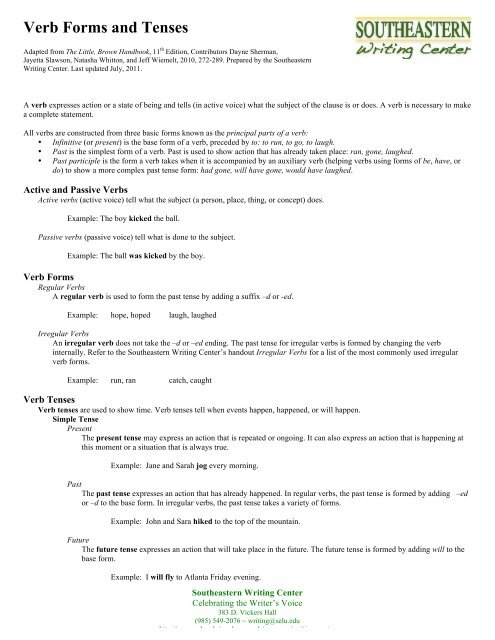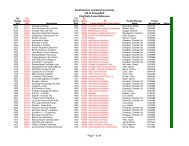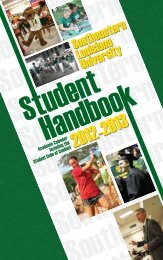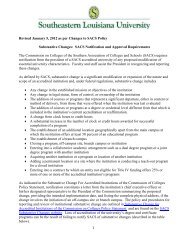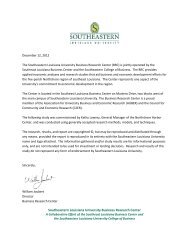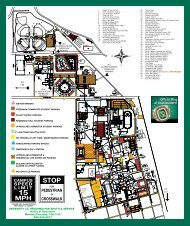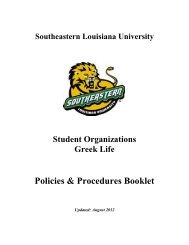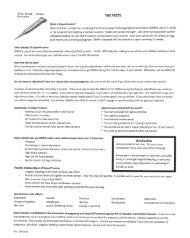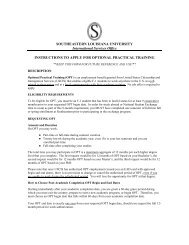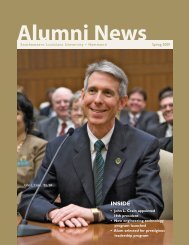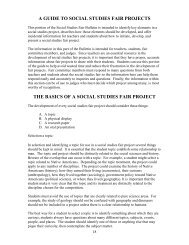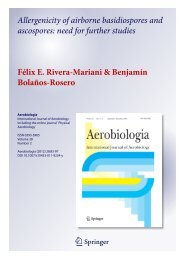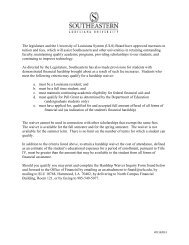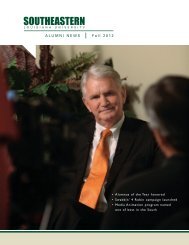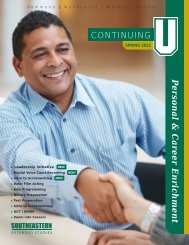Verb Forms and Tenses
Verb Forms and Tenses
Verb Forms and Tenses
Create successful ePaper yourself
Turn your PDF publications into a flip-book with our unique Google optimized e-Paper software.
<strong>Verb</strong> <strong>Forms</strong> <strong>and</strong> <strong>Tenses</strong><br />
Adapted from The Little, Brown H<strong>and</strong>book, 11 th Edition, Contributors Dayne Sherman,<br />
Jayetta Slawson, Natasha Whitton, <strong>and</strong> Jeff Wiemelt, 2010, 272-289. Prepared by the Southeastern<br />
Writing Center. Last updated July, 2011.<br />
A verb expresses action or a state of being <strong>and</strong> tells (in active voice) what the subject of the clause is or does. A verb is necessary to make<br />
a complete statement.<br />
All verbs are constructed from three basic forms known as the principal parts of a verb:<br />
• Infinitive (or present) is the base form of a verb, preceded by to: to run, to go, to laugh.<br />
• Past is the simplest form of a verb. Past is used to show action that has already taken place: ran, gone, laughed.<br />
• Past participle is the form a verb takes when it is accompanied by an auxiliary verb (helping verbs using forms of be, have, or<br />
do) to show a more complex past tense form: had gone, will have gone, would have laughed.<br />
Active <strong>and</strong> Passive <strong>Verb</strong>s<br />
Active verbs (active voice) tell what the subject (a person, place, thing, or concept) does.<br />
Example: The boy kicked the ball.<br />
Passive verbs (passive voice) tell what is done to the subject.<br />
Example: The ball was kicked by the boy.<br />
<strong>Verb</strong> <strong>Forms</strong><br />
Regular <strong>Verb</strong>s<br />
A regular verb is used to form the past tense by adding a suffix –d or -ed.<br />
Example: hope, hoped laugh, laughed<br />
Irregular <strong>Verb</strong>s<br />
An irregular verb does not take the –d or –ed ending. The past tense for irregular verbs is formed by changing the verb<br />
internally. Refer to the Southeastern Writing Center’s h<strong>and</strong>out Irregular <strong>Verb</strong>s for a list of the most commonly used irregular<br />
verb forms.<br />
Example: run, ran catch, caught<br />
<strong>Verb</strong> <strong>Tenses</strong><br />
<strong>Verb</strong> tenses are used to show time. <strong>Verb</strong> tenses tell when events happen, happened, or will happen.<br />
Simple Tense<br />
Present<br />
The present tense may express an action that is repeated or ongoing. It can also express an action that is happening at<br />
this moment or a situation that is always true.<br />
Example: Jane <strong>and</strong> Sarah jog every morning.<br />
Past<br />
The past tense expresses an action that has already happened. In regular verbs, the past tense is formed by adding –ed<br />
or –d to the base form. In irregular verbs, the past tense takes a variety of forms.<br />
Example: John <strong>and</strong> Sara hiked to the top of the mountain.<br />
Future<br />
The future tense expresses an action that will take place in the future. The future tense is formed by adding will to the<br />
base form.<br />
Example: I will fly to Atlanta Friday evening.<br />
Southeastern Writing Center<br />
Celebrating the Writer’s Voice<br />
383 D. Vickers Hall<br />
(985) 549-2076 ~ writing@selu.edu<br />
http://www.selu.edu/acad_research/programs/writing_center
Perfect Tense<br />
Present perfect<br />
The present perfect tense is used to express an action that took place at some unspecified time in the past. The present<br />
perfect tense can also be used to express an action that began in the past <strong>and</strong> continues in the present. The present<br />
perfect tense is formed with the past tense of the verb <strong>and</strong> the helping verbs has or have.<br />
Example: Sarah has watched the movie.<br />
Past perfect<br />
The past perfect tense is used to show that one action in the past began <strong>and</strong> ended before another action in the past<br />
started. The past perfect tense is formed with the past participle of the verb <strong>and</strong> the helping verb had.<br />
Example: Sarah had seen the movie before I watched it.<br />
Future perfect<br />
The future perfect tense is used to show that one action or condition in the future will begin <strong>and</strong> end before another<br />
event in the future starts. The future perfect tense is formed with the past participle of the verb <strong>and</strong> the construction will<br />
have.<br />
Example: By the time I finish this semester, I will have read ten novels.<br />
Progressive Tense<br />
Present progressive<br />
The present progressive tense is used to show an ongoing event that is happening at the moment of speaking or<br />
writing. The present progressive tense is formed by using am, is, or are with the verb form ending in –ing.<br />
Example: The children are sleeping.<br />
Past progressive<br />
The past progressive tense is used to show a past event that was happening when another event occurred. The past<br />
progressive tense is formed by using was or were with the verb form ending in –ing.<br />
Example: The children were sleeping when we arrived.<br />
Future progressive<br />
The future progressive tense is used to show an ongoing or continuous event that will take place in the future. The<br />
future progressive tense is formed by using will be or shall be with the verb form ending in –ing.<br />
Example: The children will be sleeping when we arrive.<br />
Present perfect progressive<br />
The present perfect progressive tense is used to show an event that began in the past, continues in the present, <strong>and</strong><br />
may continue in the future. The present perfect progressive tense is form by using has been or have been with the<br />
present participle verb form ending in –ing.<br />
Example: The children have been sleeping.<br />
Past perfect progressive<br />
The past perfect progressive tense is used to show a past, ongoing event that was completed before another past event.<br />
The past perfect progressive tense is formed by using had been with the present perfect verb form ending in -ing.<br />
Example: The children had been sleeping when we arrived.<br />
Future perfect progressive<br />
The future perfect progressive tense is used to show a future, ongoing event that will happen before a specified future<br />
time. The future perfect progressive tense is formed by using will have been <strong>and</strong> the present participle verb form ending<br />
in –ing.<br />
Example: The children will have been sleeping.


